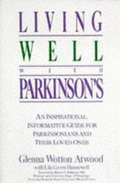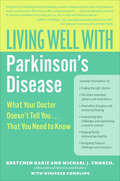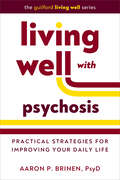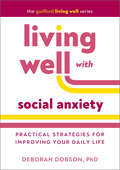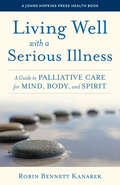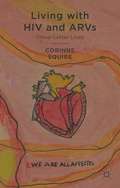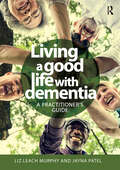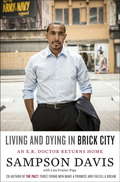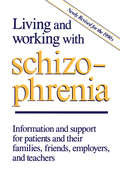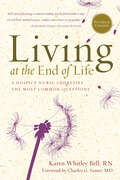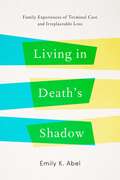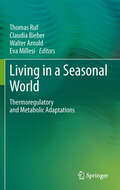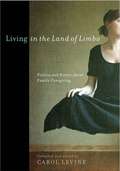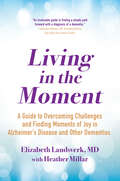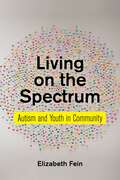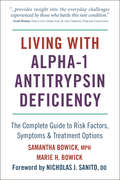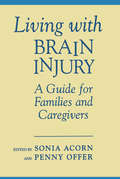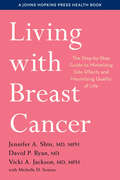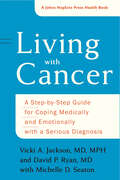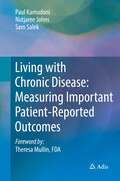- Table View
- List View
Living Well with Parkinson's
by Glenna Wotton Atwood Lila Green HunnewellPractical suggestions for everyday living, nutrition, exercise, attitude, dealing with doctors, medications, therapies, support grou Oneps, organizations in the US and Canada. One of the authors has Parkinson's and tells of her own experiences. No profanity or violence. No explicit sexual words.
Living Well with Parkinson's Disease: What Your Doctor Doesn't Tell You....That You Need to Know
by Winifred Conkling Michael J. ChurchA complete guide to Parkinson’s from two people with the disease who cofounded a national support and advocacy organization.In Living Well with Parkinson’s Disease, Gretchen Garie and Michael J. Church, a couple who both have Parkinson’s and live daily with the effects of the disease, thoroughly discuss diagnosis, treatment options, and the emotional consequences of this difficult illness. With a conversational, pragmatic, and personal tone, they offer advice on such topics as:How Parkinson’s disease affects relationshipsThe role of diet, supplements, and rest and relaxationStrategies for navigating professional life and the maze of the health-care systemHandling everyday challenges such as buttoning a shirt or rolling over in bedAnd more!Compassionate and inspiring, Living Well with Parkinson’s Disease offers knowledge and wisdom from those who understand the challenges of dealing with Parkinson’s every day.“[Gretchen and Michael’s] firsthand knowledge as patients, coupled with their years of experience as experts and advocates, allow them to offer a unique perspective. Using the information provided by Gretchen and Michael in this book, you, too, can live well with Parkinson’s disease.” —John D. Campbell, MD, neurologist and medical director for PASFL, the Parkinson’s Association of Southwest Florida
Living Well with Psychosis: Practical Strategies for Improving Your Daily Life (The Guilford Living Well Series)
by Aaron P. BrinenFor people with psychosis, recovery is a winding path, not a straight line. And the best person to steer your recovery is you. Leading psychologist Aaron P. Brinen busts myths and helps you build the life you want in this empowering book. Dr. Brinen provides step-by-step guidance for becoming a strong self-advocate, navigating treatment options, managing symptoms that cause distress, and coping with stigma. Learn crucial ways to connect with others, pursue your goals at school or work, and keep your body healthy. The brief chapters are warm and compassionate, with downloadable practical tools designed to boost your energy and motivation for getting out into the world. This is a book you can read cover to cover--or dip into any time you need extra support to live well and feel good.
Living Well with Social Anxiety: Practical Strategies for Improving Your Daily Life (The Guilford Living Well Series)
by Deborah DobsonIf you have social anxiety, change is hard, and making it stick can be even harder. In this empathic guide, psychologist and anxiety expert Deborah Dobson helps you better understand social anxiety and get out into the world with more confidence. The book is packed with ideas and tips for approaching frequently avoided situations--from making small talk to public speaking to asking someone on a date--one manageable step at a time. Concise, encouraging chapters feature vivid stories, examples, and downloadable practical tools. Dive into this book cover to cover or turn to it when specific problems arise. Getting out of your comfort zone is scary and will feel risky, but it opens up new pathways to the life you really want.
Living Well with Type 2 Diabetes: A Whole Person Understanding and Approach (Living Well)
by Pamela Myles-Hooton Dr John GedneyA practical, self-help guide for living well with Type 2 Diabetes (T2D) In the last forty years, we have seen an astounding rise in the prevalence of T2D in most countries. There are thought to be close to half a billion people affected worldwide. Traditionally thought of as a disease of mid-life and old age, both T2D and the metabolic markers of future disease are now increasingly being seen in young people, children and even infants. The burden of this disease is huge at all levels − for healthcare spend and for added risk of other medical problems. Other than its physical impacts, more than a third of people with T2D are said to experience psychological problems related specifically to the condition. We are now at a crossroads in understanding the science behind T2D with a more focused approach emerging. Research and practice are challenging the traditional way in which we approach and manage T2D − as well as better understanding how to prevent it altogether. By following the advice in this book, you will: · Better understand and be empowered to control your metabolic health · Learn how to prevent, reverse, or improve, and better manage your T2D Living Well self-help guides use clinically proven techniques to treat long-standing and disabling conditions, both psychological and physical.
Living Well with Type 2 Diabetes: A Whole Person Understanding and Approach (Living Well)
by Pamela Myles-Hooton Dr John GedneyA practical, self-help guide for living well with Type 2 Diabetes (T2D) In the last forty years, we have seen an astounding rise in the prevalence of T2D in most countries. There are thought to be close to half a billion people affected worldwide. Traditionally thought of as a disease of mid-life and old age, both T2D and the metabolic markers of future disease are now increasingly being seen in young people, children and even infants. The burden of this disease is huge at all levels − for healthcare spend and for added risk of other medical problems. Other than its physical impacts, more than a third of people with T2D are said to experience psychological problems related specifically to the condition. We are now at a crossroads in understanding the science behind T2D with a more focused approach emerging. Research and practice are challenging the traditional way in which we approach and manage T2D − as well as better understanding how to prevent it altogether. By following the advice in this book, you will: · Better understand and be empowered to control your metabolic health · Learn how to prevent, reverse, or improve, and better manage your T2D Living Well self-help guides use clinically proven techniques to treat long-standing and disabling conditions, both psychological and physical.
Living Well with a Serious Illness: A Guide to Palliative Care for Mind, Body, and Spirit (A Johns Hopkins Press Health Book)
by Robin Bennett KanarekA practical guide for understanding how palliative care can improve quality of life for patients and their caregivers.Robin Bennett Kanarek was a registered nurse working with patients suffering from chronic medical conditions when her ten-year-old son was diagnosed with leukemia. As her son endured grueling treatments, Robin realized how often medical professionals overlook critical psychological, emotional, and spiritual support for people with life-threatening illnesses. Living Well with a Serious Illness is the culmination of decades of Robin's work to advance the field of palliative care.Although palliative care is often associated with hospice and end-of-life planning, Kanarek argues for a more expanded definition that incorporates palliative care earlier in patients' journeys. Living Well with a Serious Illness helps patients and their caregivers understand• what palliative care entails• how to access the support they need when going through a serious illness• what questions to ask medical professionals • how to navigate advanced care planning• definitions of common terminology used with end-of-life planning• the importance of spiritual care, coping strategies, and emotional support• how to become an advocate for palliative careThis book illuminates the importance of seeing patients as individuals who can benefit from care for their body, mind, and spirit—the core tenet of palliative care.
Living With Hiv And Arvs
by Corinne SquireThis book explores the possibilities and difficulties of living with HIV and ARVs, or antiretroviral treatment, today. It draws on HIV-positive people's stories from both the UK and the South African epidemics and offers a deep understanding of the continuing difficulties of living with HIV and the effective strategies for coping that have evolved.
Living a good life with Dementia: A practitioner's guide
by Liz Leach Murphy Jayna PatelA practical guide to helping those living with dementia live their best life in a way that makes sense to them.Essential reading for anyone working with people living with dementia, this book explains the concept of Self-Directed Support and Care for people living with dementia and links the various Person Centred approaches within dementia care with Person Centred Planning and Community based approaches. As the content unfolds, the concept of the Dementia Care Triad (people living with dementia, unpaid carers and professional carers) is explored and developed further to include the layer of community. The links between the health and social care legal context, guidance documents and national dementia strategies are presented with good, actionable practice, approaches, tools and informed advice to achieve Person Centred dementia care and support, with an emphasis on communities Living a Good Life with Dementia will help professionals and carers gain knowledge and insight to be able to develop creative ideas for the care and support they want to have in place.
Living and Dying in Brick City: Stories from the Front Lines of an Inner-City E.R.
by Sampson Davis Lisa Frazier PageA riveting personal exploration of the healthcare crisis facing inner-city communities, written by an emergency room physician who grew up in the very neighborhood he is now serving Sampson Davis is best known as one of three friends from inner-city Newark who made a pact in high school to become doctors. Their book The Pact and their work through the Three Doctors Foundation have inspired countless young men and women to strive for goals they otherwise would not have dreamed they could attain. In this book, Dr. Davis looks at the healthcare crisis in the inner city from a rare perspective: as a doctor who works on the front line of emergency medical care in the community where he grew up, and as a member of that community who has faced the same challenges as the people he treats every day. He also offers invaluable practical advice for those living in such communities, where conditions like asthma, heart disease, stroke, obesity, and AIDS are disproportionately endemic. Dr. Davis's sister, a drug addict, died of AIDS; his brother is now paralyzed and confined to a wheelchair as a result of a bar fight; and he himself did time in juvenile detention--a wake-up call that changed his life. He recounts recognizing a young man who is brought to the E.R. with critical gunshot wounds as someone who was arrested with him when he was a teenager during a robbery gone bad; describes a patient whose case of sickle-cell anemia rouses an ethical dilemma; and explains the difficulty he has convincing his landlord and friend, an older woman, to go to the hospital for much-needed treatment. With empathy and hard-earned wisdom, Living and Dying in Brick City presents an urgent picture of medical care in our cities. It is an important resource guide for anyone at risk, anyone close to those at risk, and anyone who cares about the fate of our cities. Praise for Living and Dying in Brick City "This book just might save your life. Sampson Davis shares fascinating stories from the E.R. and addresses the inner-city health crisis. His book is an important investment in your most valuable resource: your health."--Suze Orman, author of The Money Class "This book is living proof that behind the boarded-up windows of one of America's most neglected cities, beyond the sorrow and the pain, there is much more than we've come to expect. There is hope. There is change. There is redemption for Brick City. The book will open your eyes to a part of the world that most of us only see from behind the wheel of a tightly locked car. Sampson Davis is not afraid to lift heavy objects in this world. I'm glad he shared his journey with us, so that we know it is possible."--James McBride, author of The Color of WaterFrom the Hardcover edition.
Living and Working with Schizophrenia
by Joel J. JeffriesFor the families of schizophrenics, fear, guilt, frustration, and despair can become part of daily life. Several years ago the authors of this volume established a program at the Clarke Institute of Psychiatry in Toronto to help the families of schizophrenics cope with the sometimes debilitating emotions they typically experience. The first edition of Living and Working with Schizophrenia grew out of that program. Published to international acclaim in 1982, it offered practical advice and clear, accessible information to those who suffer from schizophrenia, their relatives, friends, teachers, and employers.This edition has been completely updated and includes entirely new sections and more case vignettes. The authors have expanded the information on family education, counseling, and social issues, addressing such topics as community organizations, adoption, pregnancy, parenting, and sexuality.From the medical perspective, the authors explore in detail diagnosis and prognosis and describe the drugs used in the treatment of schizophrenia, with information on their effects and side-effects. The latest research is taken into account, and all is explained in language readily understood by the lay reader.
Living at the End of Life: A Hospice Nurse Addresses the Most Common Questions
by Karen Whitley BellAn updated edition of the most respected book on hospice care—for both patients and caregivers. This warm and informative resource on hospice and other end-of-life care options now gets an update. It receives a new preface and revised guidance on elders who need more long-term care and support, recommendations on pain medications, and advice for those living extended lives with treatable, but not curable, diseases. Written by a hospice nurse, Living at the End of Life reassures us that this difficult time also offers an opportunity to explore and rediscover a richer meaning in life. Drawing on her years of experience, Bell has created a comprehensive, insightful guide to every aspect of hospice care and the final stages of life. For people in hospice, as well as their friends and families, this is an indispensable and trustworthy source of comfort and spiritual healing.
Living in Death’s Shadow: Family Experiences of Terminal Care and Irreplaceable Loss
by Emily K. AbelChallenging assumptions about caregiving for those dying of chronic illness.What is it like to live with—and love—someone whose death, while delayed, is nevertheless foretold? In Living in Death’s Shadow, Emily K. Abel, an expert on the history of death and dying, examines memoirs written between 1965 and 2014 by family members of people who died from chronic disease. In earlier eras, death generally occurred quickly from acute illnesses, but as chronic disease became the major cause of mortality, many people continued to live with terminal diagnoses for months and even years. Illuminating the excruciatingly painful experience of coping with a family member’s extended fatal illness, Abel analyzes the political, personal, cultural, and medical dimensions of these struggles.The book focuses on three significant developments that transformed the experiences of those dying and their intimates: the passage of Medicare and Medicaid, the growing use of high-tech treatments at the end of life, and the rise of a movement to humanize the care of dying people. It questions the exalted value placed on acceptance of mortality as well as the notion that it is always better to die at home than in an institution. Ultimately, Living in Death’s Shadow emphasizes the need to shift attention from the drama of death to the entire course of a serious chronic disease. The chapters follow a common narrative of life-threatening disease: learning the diagnosis; deciding whether to enroll in a clinical trial; acknowledging or struggling against the limits of medicine; receiving care at home and in a hospital or nursing home; and obtaining palliative and hospice care. Living in Death’s Shadow is essential reading for everyone seeking to understand what it means to live with someone suffering from a chronic, fatal condition, including cancer, AIDS, Alzheimer’s, and heart disease.
Living in a Seasonal World
by Walter Arnold Claudia Bieber Eva Millesi Thomas RufThis book summarises the newest information on seasonal adaptation in animals. Topics include animal hibernation, daily torpor, thermoregulation, heat production, metabolic depression, biochemical adaptations, neurophysiology and energy balance. The contributors to this book present interdisciplinary research at multiple levels ranging from the molecular to the ecophysiological, as well as evolutionary approaches. The chapters of this book provide original data not published elsewhere, which makes it the most up-to-date, comprehensive source of information on these fields. The book's subchapters correspond to presentations given at the 14th International Hibernation Symposium in August 2012 in Austria. This is a very successful series of symposia (held every four years since 1959) that attracts leading researchers in the field. Like the past symposia, this meeting - and consequently the book - is aimed not only at hibernation but at covering the full range of animal adaptations to seasonal environments. For the next four years, this book will serve as the cutting-edge reference work for graduate students and scientists active in this field of physiology and ecology. .
Living in the Land of Limbo: Fiction and Poetry about Family Caregiving
by Carol LevineLiving in the Land of Limbo is the first anthology of short stories and poems about family caregivers. These men and women find themselves in "limbo," as they struggle to take care of a family member or friend in the uncertain world of chronic illness. The authors explore caregivers' experiences as they deal with family conflicts, the complexities of the health care system, and the impact of their choices on their lives and the lives of others. The book includes selections devoted to caregivers of aging parents; husbands and wives; ill children; and relatives, lovers, and friends. A final section is devoted to paid caregivers and their clients. Among the conditions that form the background of the selections are dementia, HIV/AIDS, mental illness, multiple sclerosis, and pediatric cancer. Many of the authors are well-known poets and writers, but others have not been published in mainstream media. They represent a range of cultural backgrounds. Although their works approach caregiving in very different ways, the authors share a commitment to emotional truth, unvarnished by societal ideals of what caregivers should feel and do. These stories and poems paint profoundly moving and revealing portraits of family caregivers.
Living in the Land of Limbo: Fiction and Poetry about Family Caregiving
by Carol LevineAAUP Books Committee "Outstanding" Title of 2015Living in the Land of Limbo is the first anthology of short stories and poems about family caregivers. These men and women find themselves in "limbo," as they struggle to take care of a family member or friend in the uncertain world of chronic illness. The authors explore caregivers' experiences as they deal with family conflicts, the complexities of the health care system, and the impact of their choices on their lives and the lives of others. The book includes selections devoted to caregivers of aging parents; husbands and wives; ill children; and relatives, lovers, and friends. A final section is devoted to paid caregivers and their clients. Among the conditions that form the background of the selections are dementia, HIV/AIDS, mental illness, multiple sclerosis, and pediatric cancer. Many of the authors are well-known poets and writers, but others have not been published in mainstream media. They represent a range of cultural backgrounds. Although their works approach caregiving in very different ways, the authors share a commitment to emotional truth, unvarnished by societal ideals of what caregivers should feel and do. These stories and poems paint profoundly moving and revealing portraits of family caregivers.
Living in the Moment: A Guide to Overcoming Challenges and Finding Moments of Joy in Alzheimer's Disease and Other Dementias
by Elizabeth Landsverk, MDAn invaluable, comprehensive guide that explains everything you and your family need to know about living well with Alzheimer&’s disease and other dementias. A loved one&’s dementia diagnosis can leave you feeling scared and overwhelmed. Now a renowned geriatrician who has helped thousands of families live happy, engaged lives—after a dementia diagnosis—shares her expertise in this easy-to-follow guide. Filled with must-have information, practical advice, and unique and comforting insights, here is everything you need to know about caring for your loved one and making his or her life the best possible—starting now, even as the disease progresses. Inside, you&’ll find: · How to create a plan of action for today—and tomorrow—that will help all involved cope with this new normal · How to keep your vulnerable loved one safe and secure—both physically and financially · Lifestyle changes, innovative new activities, and holistic interventions that can slow the progression of dementia · Comprehensive information on both prescription and OTC medications that can help or hurt dementia patients · Dealing with day-to-day challenges, from staying mobile to overcoming agitation and aggression without resorting to sedation · How and where to get help, including online support groups, home health care agencies, care managers, neuropsychologists, communities and day programs for people with dementia, and government agencies · Tips on keeping your loved one at home versus placement in a long-term care facility In addition to all the essential advice, Dr. Landsverk demystifies the ins and outs of dementia, explaining what it is and what it&’s not, and making sure you and your loved one will be ready to address whatever develops and maintain quality of life. Uniquely, Living in the Moment will transform how you think about dementia, providing comfort and support for the best life possible—at any stage.
Living in the Moment: Overcoming Challenges and Finding Moments of Joy in Alzheimer's Disease and Other Dementias
by Elizabeth LandsverkAn invaluable, comprehensive guide that explains everything you and your family need to know about living well with Alzheimer's disease and other dementias.A loved one's dementia diagnosis can leave you feeling scared and overwhelmed. Now a renowned consultant geriatrician, who has helped thousands of families live happy, engaged lives - after a dementia diagnosis - shares her expertise in this easy-to-follow guide.Filled with must-have information, practical advice, and unique and comforting insights, here is everything you need to know about caring for your loved one and making his or her life the best possible - starting now, even as the disease progresses. Inside, you'll find:* How to create a plan of action for today, and tomorrow, that will help all involved cope with this new normal* How to keep your vulnerable loved one safe and secure both physically and financially* Lifestyle changes, innovative new activities, and holistic interventions that can slow the progression of dementia* Comprehensive information on both prescription and over-the-counter medications that can help or hurt dementia patients* Dealing with day-to-day challenges, from staying mobile to overcoming agitation and aggression without resorting to sedation* How and where to get help* Tips on keeping your loved one comfortable in their own home In addition to all the essential advice, Dr. Landsverk demystifies the ins and outs of dementia, explaining what it is and what it's not, and making sure you and your loved one will be ready to address whatever develops and maintain quality of life. Uniquely, Living in the Moment will transform how you think about dementia, providing comfort and support for the best life possible - at any stage.
Living in the Shadows of China's HIV/AIDS Epidemics: Sex, Drugs and Bad Blood (Routledge Contemporary China Series)
by Shelley TorcettiIdentifying the existing challenges and shortfalls of China's current HIV/AIDS programming, this book provides an understanding of the history of HIV/AIDS in China, comparing government responses to global best practice in prevention and treatment. Considering three key populations in China, namely, female sex workers, people who inject drugs and floating migrants, Living in the Shadows of China's HIV/AIDS Epidemics highlights the effects of high mobility and marginalisation on the spread of HIV in China. It is argued that these groups often suffer from stigmatisation and a lack of human security, resulting in sub-optimal outcomes for HIV/AIDS intervention and prevention efforts and the reinforcement of high-risk behaviours, further contributing to the transmission of the virus to the general population. In adding to the emerging body of literature, this book further elucidates the myriad of challenges posed by HIV/AIDS epidemics, allowing sustained engagement and a fresh insight into how governments might respond to the needs of individuals living with HIV/AIDS, both in China and globally. Including case studies which give voice to research participants in a rich and engaging way, this book will appeal to students and scholars of Chinese Studies, Asian Studies, International Relations and Political Science, as well as those engaged in epidemiological studies in the Health Sciences.
Living on the Spectrum: Autism and Youth in Community (Anthropologies of American Medicine: Culture, Power, and Practice #8)
by Elizabeth FeinHonorable Mention, 2020 Stirling Prize for Best Published Work in Psychological Anthropology, given by the Society for Psychological AnthropologyHonorable Mention, New Millennium Book Award, given by the Society for Medical AnthropologyHow youth on the autism spectrum negotiate the contested meanings of neurodiversityAutism is a deeply contested condition. To some, it is a devastating invader, harming children and isolating them. To others, it is an asset and a distinctive aspect of an individual’s identity. How do young people on the spectrum make sense of this conflict, in the context of their own developing identity? While most of the research on Asperger’s and related autism conditions has been conducted with individuals or in settings in which people on the spectrum are in the minority, this book draws on two years of ethnographic work in communities that bring people with Asperger’s and related conditions together. It can thus begin to explore a form of autistic culture, through attending to how those on the spectrum make sense of their conditions through shared social practices.Elizabeth Fein brings her many years of experience in both clinical psychology and psychological anthropology to analyze the connection between neuropsychological difference and culture. She argues that current medical models, which espouse a limited definition, are ill equipped to deal with the challenges of discussing autism-related conditions. Consequently, youths on the autism spectrum reach beyond medicine for their stories of difference and disorder, drawing instead on shared mythologies from popular culture and speculative fiction to conceptualize their experience of changing personhood. In moving and persuasive prose, Living on the Spectrum illustrates that young people use these stories to pioneer more inclusive understandings of what makes us who we are.
Living with Alpha-1 Antitrypsin Deficiency: Complete Guide to Risk Factors, Symptoms & Treatment Options (Living with)
by Samantha Bowick Marie BowickA knowledgeable handbook with a patient's perspective for those afflicted with the incurable disease known as Alpha-1 Antitrypsin deficiency (A1AD).Alpha-1 Antitrypsin deficiency (A1AD) is a rare genetic, incurable disease which causes the liver to not produce enough of a certain protein that protects and keeps the lungs functional. 100,000 people in the United States have A1AD and 19 million more are carriers for the disease. Since it's so rare, the information available about A1AD has been lacking especially for those suffering unknowingly with the disease. Living with Alpha-1 Antitrypsin Deficiency offers the most up-to-date and comprehensive information on this illness and includes first-hand experience from someone managing the disease. Living with Alpha-1 Antitrypsin Deficiency also includes expert advice from doctors and researchers tackling the disease, with tips on recognizing symptoms and getting the most effective help possible.
Living with Brain Injury: A Guide for Families and Caregivers
by Sonia Acorn Penny OfferAn injury to the brain can affect every aspect of a person's daily life, including physical abilities and psychological make-up, relationships and family roles, school and employment, recreation and leisure. At the hospital, you may hear a lot about brain injury but not realize the importance of what you've learned until you have to deal with the injured person at home. In this handy reference book, health-care and legal experts from Canada and the United States guide you through the process of rehabilitation and help you learn how to live with brain injury. The advice of these professionals is complemented by the stories of two people who have survived injuries and are adjusting to their new lives.
Living with Breast Cancer: The Step-by-Step Guide to Minimizing Side Effects and Maximizing Quality of Life (A Johns Hopkins Press Health Book)
by Vicki A. Jackson David P. Ryan Jennifer A. ShinYour complete resource for handling the physical and emotional effects of breast cancer treatments.At the time of diagnosis, breast cancer patients are faced with many overwhelming decisions about possible treatments. Living with Breast Cancer provides you with an overview of what to expect from testing and treatment, which cancer specialists you may need to see, and common terms to use to help communicate your needs to your team. This empathetic resource full of relatable stories teaches patients and caregivers how to ask the right questions to get the best possible care. The authors explain how to minimize the symptoms and side effects of treatment and outline coping strategies to deal with the stress of breast cancer treatment, including the changes in your body from cancer and its therapies. The book helps readers• make sense of their diagnosis• set goals and prepare for treatment• understand the different types of therapies, tests, and scans• manage the symptoms and side effects of treatment, such as nausea, fatigue, shortness of breath, weight fluctuations, and depression• learn what medications and lifestyle modifications can help with symptoms• live and cope with progressive cancerLiving with Breast Cancer is your definitive resource for handling the physical and emotional effects of breast cancer and treatment.
Living with Cancer: A Step-by-Step Guide for Coping Medically and Emotionally with a Serious Diagnosis (A Johns Hopkins Press Health Book)
by Michelle D. Seaton Vicki A. Jackson David P. RyanA comprehensive and compassionate guide for patients and families living with the physical and emotional effects of cancer.The prospect of entering treatment is overwhelming for anyone facing a diagnosis of cancer. While patients have access to a vast amount of medical information online, this advice is often unreliable or confusing. In Living with Cancer, Drs. Vicki A. Jackson and David P. Ryan have crafted the first step-by-step guide aimed at helping people with this life-defining disease grasp what’s happening to them while coping physically and emotionally with cancer treatment. An empathetic resource full of relatable patient stories, this book teaches patients and caregivers how to ask the right questions to get the best possible care—beginning at the moment of diagnosis. Drs. Jackson and Ryan explain how to work with a team of doctors and nurse practitioners to minimize symptoms and side effects while living as fully as possible in the face of cancer. They relay important information about understanding prognosis, and they translate what doctors mean when they describe tests, treatments, and medical procedures. Finally, they discuss hospice care and answer questions about continuing treatment and managing the final phase of life.Based on new research and a groundbreaking program in which patients are treated with palliative care—along with the best cancer care—during the course of their illness, this honest and caring book provides the right advice to use at the right time throughout a journey with cancer. It allows a person with cancer to concentrate on living the best life possible, despite an uncertain future. Patients at every stage will find Living with Cancer a comprehensive, thoughtful, and accessible guide for navigating the illness and its treatment.
Living with Chronic Disease: Measuring Important Patient-Reported Outcomes
by Sam Salek Paul Kamudoni Nutjaree JohnsThis book serves as a roadmap for the development and application of patient-reported outcome (PRO) measures, supporting beginners through to experts, as a practical guide. To elucidate on key concepts in the book, examples from clinical research in hyperhidrosis and health-related quality of life and medicines clinical development context, are used. Health-related quality of life represents one of the most commonly measured PROs in both routine clinical practice and research. The book demonstrates the importance of PROs to patients with chronic disease and how such outcomes can assist clinicians in managing patients and monitoring their response to treatment in terms of both symptoms and impacts. This book will benefit readers as a single-source practical guide on the development of modern PRO measures and may also serve as a blueprint for the conceptualization and planning of evidence generation related to PROs in various settings. Ideas and suggestions on how to navigate recent developments shaping the field of PRO measurement are also offered.
